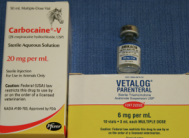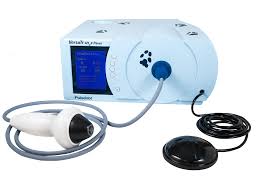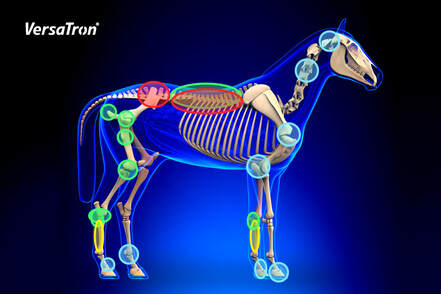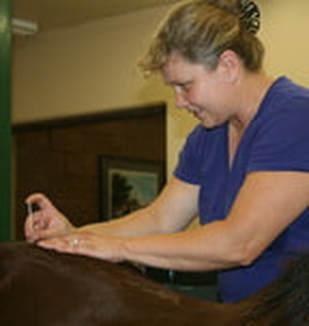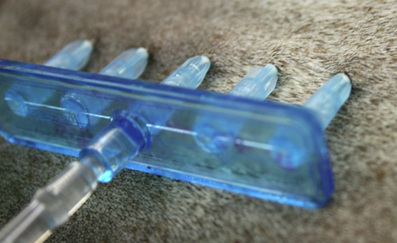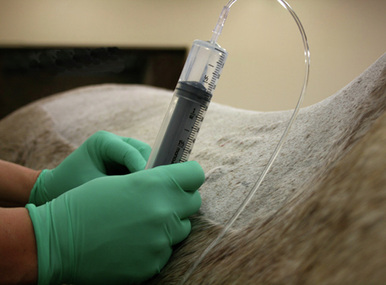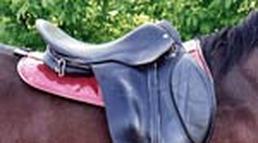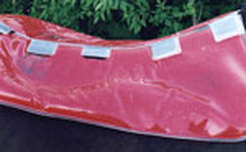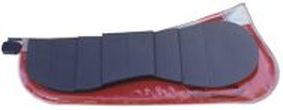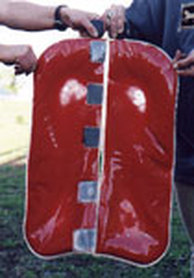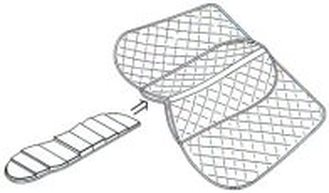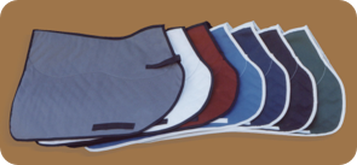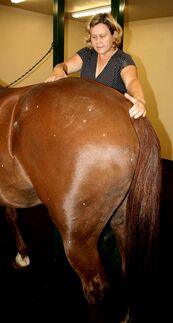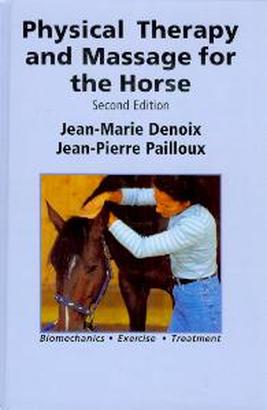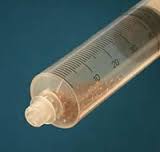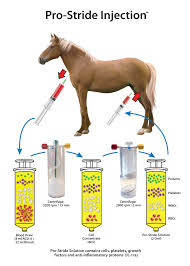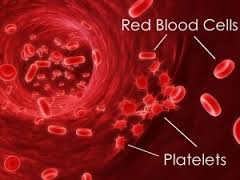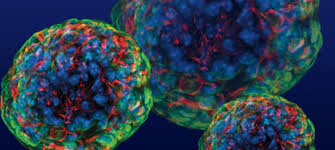Equine Sports Medicine at Morgan Equine
Focused Shock Wave Therapy
|
VersaTron® shock wave device is often imitated, but remains unmatched in clinical research, quality, and effectiveness in the treatment of over 20 equine indications. VersaTron® generates the highest peak pressure (energy) of any system with the largest focal volume, ideal for treating deep orthopedic conditions in horses. The focused energy increases blood supply to the treated area, resulting in tissue regeneration in tendons, joints, and bone.
|
|
VersaTron Shock Wave TherapyShock wave is a noninvasive, high-energy pressure wave treatment, which is commonly used in human and veterinary medicine. It helps the body in relieving pain, speeding healing and improving quality of healing.
Shock wave treatments can help your horse to return to work more quickly and has a more than a decade of clinical success behind it. The VersaTron is covered by most all insurance companies (up to 3 treatments) so it’s a beneficial option to owners. |
The VersaTron system has been proven effective for treating such conditions as:
- Tendon and ligament injuries (Suspensory/Deep Digital Flexor Tendon)
- Bone Fractures (stress fractures/splints)
- OA/Joint inflammation and pain
- Foot Injuries (Desmitis/Navicular syndrome/Ringbone/Chronic Heel Pain)
- Wounds
- Back pain/Kissing spines
Equine Acupuncture & Mesotherapy
|
Trained by the International Veterinary Acupuncture Society, Dr. Morgan has utilized acupuncture as a complimentary therapy for the past 20 years.
The most recent needle therapy that has successfully helped many horses is Mesotherapy. It is especially helpful in chronic back pain horses where bone lesions of the neck and back can be documented. It is one of Dr. Morgan's favorite therapy's for sore backed horses. |
The horse is given a light sedation and the back is prepared using a sterile technique. Several medications are combined in a large syringe that is attached to a "meso-injector" which is a small cartridge that accepts 5 very small needles. The needles are placed into the skin and medication is "blebbed" into the skin, causing the skin to rise to accommodate the medication. The blebs reduce in about an hour, but the main target is a pain feedback mechanism that is located in the skin layer. We have had excellent results with this therapy.
Horses are typically not ridden for 3 days after mesotherapy and all saddle pads and blankets must be washed. If you know that your horse is having mesotherapy, please bring a clean stable or turn out sheet for your horse to wear home.
Horses are typically not ridden for 3 days after mesotherapy and all saddle pads and blankets must be washed. If you know that your horse is having mesotherapy, please bring a clean stable or turn out sheet for your horse to wear home.
Equine Chiropractic
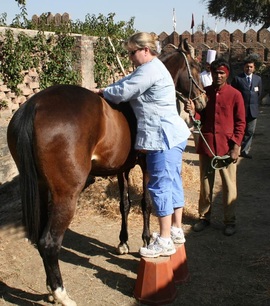
Chiropractic in India
Chiropractic work on horses should be done by a Veterinarian or Human Chiropractor who has been certified by the American Veterinary Chiropractic Association or similar organization with national credentials. If your "chiropractor" does not have a DVM or DC behind their name with extensive veterinary chiropractic training, they are preforming work illegally and you are paying an under-qualified individual who does not have liability to you, your horse or any governed board. It's illegal to practice chiropractics with out qualifications in most states, including New York!
Dr. Morgan received her animal chiropractic training and certification after veterinary school from the American Veterinary Chiropractic Association. The most beneficial part of the training was how to understand the very complex vertebral structures and how the body reacts to dysfunction.
Many horses with primary neck, back or pelvis issues benefit greatly from chiropractic manipulation. In her experience, horses are typically not "repeat" offenders. That means that most vertebral "subluxations" are temporary or have occurred because of a single situation and are easily adjusted. If there is an issue that keeps coming up, there is usually a primary limb lameness with a secondary neck, back or pelvis issue that resolves itself once the horse is treated for the issue that makes the neck, back or pelvis unhappy.
Lots of people can't believe that you can adjust a horse. They are so big. How can it be possible? It is possible because we are not adjusting a whole horse, we are evaluating and manipulating just one small vertebral segment at a time. We are looking for correct range of motion and flexibility. We won't say that it's easy work, because it can be difficult to get in the correct position for manipulation and difficult to get horses to submit through range of motion, but it should not be a dramatic performance. Definitely NO mallets or hammers of any kind!
Dr. Morgan received her animal chiropractic training and certification after veterinary school from the American Veterinary Chiropractic Association. The most beneficial part of the training was how to understand the very complex vertebral structures and how the body reacts to dysfunction.
Many horses with primary neck, back or pelvis issues benefit greatly from chiropractic manipulation. In her experience, horses are typically not "repeat" offenders. That means that most vertebral "subluxations" are temporary or have occurred because of a single situation and are easily adjusted. If there is an issue that keeps coming up, there is usually a primary limb lameness with a secondary neck, back or pelvis issue that resolves itself once the horse is treated for the issue that makes the neck, back or pelvis unhappy.
Lots of people can't believe that you can adjust a horse. They are so big. How can it be possible? It is possible because we are not adjusting a whole horse, we are evaluating and manipulating just one small vertebral segment at a time. We are looking for correct range of motion and flexibility. We won't say that it's easy work, because it can be difficult to get in the correct position for manipulation and difficult to get horses to submit through range of motion, but it should not be a dramatic performance. Definitely NO mallets or hammers of any kind!
Saddle Fitting
Dr. Morgan uses the Port Lewis Saddle Fitting System to take the guesswork out of english, western and treeless saddle fit.
When the Impression Pad is placed under a saddle it produces a visual record of how the weight is distributed through the panels to the horse. It's a quick and easy way for riders (even those with a tight budget) to assess and do something about the fit of their saddle right away. The Impression Pad is made from clear flexible vinyl and contains a red moldable putty which is affectionately called Equi-Dough.
It is extremely easy to use. Place the impression pad on your horse's back, girth up and go for a ride... that's it! When you remove the saddle, you will have an exact impression of how that saddle fits that horse, with that rider.
It is extremely easy to use. Place the impression pad on your horse's back, girth up and go for a ride... that's it! When you remove the saddle, you will have an exact impression of how that saddle fits that horse, with that rider.
A Correction Pad is specifically built for your horse by using various thickness black foam panels are assembled on a panel to relieve or support deficient areas. The right and the left side are built independently. The panels are then put into a pocketed Correction Pad. Go for another ride with the correction pad to make sure the build is correct.
|
Once there is satisfaction with the correction, its time to choose your style, shape, color and trim for the finished pad. There are many english and western options.
The finished pads with the correction panels are a combination of Cordura rip-stop nylon shell and two layers of quilted cotton. The Pads are elegant enough for the show ring, yet durable enough to stand up to everyday use. Be sure to mention you are interested in a saddle fitting so we can schedule enough time to complete the process. The cost is approximately $300-350 for the fitting and the finished pad. |
Physical Therapy & Rehabilitation
|
Seems like everyone has a romanticized idea of what equine physical therapy and rehabilitation is. There has to be mystery and magic and an endless list of things to try, right? If your thinking mystery and magic are easier, cheaper or more natural, don't bother reading any further.
For those of you with an open mind we would like to encourage you to think about physical therapy and rehabilitation a bit differently. In simple terms and straight to the point, a correct diagnosis will organically lead to a physical therapy, rehabilitation or exercise protocol that is right for your horse. |
We can all agree the most important goal is to relieve acute or chronic pain and prevent further injury. The process begins by designing therapeutic programs based upon diagnoses with a realistic and clear assessment of the end goal for the horse. We have the science. Let's use it.
Well thought out plans might include rehabilitative exercise protocols, massage, muscle stimulation, electrical nerve stimulation, therapeutic ultrasound, hyperbaric oxygen therapy, underwater treadmill, shockwave therapy, chiropractic, acupuncture, shoeing and nutrition. It may even include medications and surgery!
If you want to use the terms physical therapy and rehabilitation you should be familiar with the cause and medical or surgical therapy for three prominent categories of injury:
Well thought out plans might include rehabilitative exercise protocols, massage, muscle stimulation, electrical nerve stimulation, therapeutic ultrasound, hyperbaric oxygen therapy, underwater treadmill, shockwave therapy, chiropractic, acupuncture, shoeing and nutrition. It may even include medications and surgery!
If you want to use the terms physical therapy and rehabilitation you should be familiar with the cause and medical or surgical therapy for three prominent categories of injury:
- Soft Tissue: Tendons and Ligaments
- Bone and Joint
- Nervous, Muscle, Skin and Hooves
|
The questions you should be asking next are:
What is the response to injury and healing of that condition? Which conditions are appropriate for physical therapy? What are the therapeutic modalities that have an affect on this condition? Once the right modalities are identified, ask these questions: When is it appropriate to begin treatment? What is the frequency or duration of treatment? How will we measure response to therapy? What is a reasonable time frame for response? Who else do we need to include in the team approach? |
Sorry to take the magic and mystery out of it. A well thought out process is going to be much more time and cost effective than random treatments that are sworn to work by your neighbor for another horse with a completely different condition and no record of actual progress. If you want a scientifically based place to start, we recommend a correct diagnosis and JM Denoix's book as an excellent base.
Regenerative Medicine at Morgan Equine
All the Regenerative Medicine buzz words...
You may have heard or read about IRAP, PRP, Prostride, Noltrex or Stem Cells in conversation or featured in horse magazines. What can they do for your horse?
They represent the majority of Regenerative Medicine products currently available. Once a lesion or problem has been identified and proved to be the issue that is causing pain, regenerative products may become part of the therapeutic plan.
The general principle is to use the patients own blood or fat to concentrate naturally made factors that promote healing. Each of the products seem to produce favorable results for certain types of lesions or pathology. It is vital to have a correct diagnosis to choose the most appropriate product. They also take time to collect and prepare prior to administering. Some products take up to 3 weeks to concentrate before the initial injection. Many also require several injections to complete the protocol. That is why they tend to be expensive.
We are able to facilitate IRAP, PRP, Prostride, Noltrex and Stem Cell regenerative medicine treatments at Morgan Equine.
They represent the majority of Regenerative Medicine products currently available. Once a lesion or problem has been identified and proved to be the issue that is causing pain, regenerative products may become part of the therapeutic plan.
The general principle is to use the patients own blood or fat to concentrate naturally made factors that promote healing. Each of the products seem to produce favorable results for certain types of lesions or pathology. It is vital to have a correct diagnosis to choose the most appropriate product. They also take time to collect and prepare prior to administering. Some products take up to 3 weeks to concentrate before the initial injection. Many also require several injections to complete the protocol. That is why they tend to be expensive.
We are able to facilitate IRAP, PRP, Prostride, Noltrex and Stem Cell regenerative medicine treatments at Morgan Equine.
Regenerative Medicine FAQs
Equine IRAP (Interleukin-1 Receptor Antagonist Protein)
What is IRAP?
IRAP (Orthokine) was originally developed in Europe, and has been used extensively in Germany. IRAP (Interleukin-1 Receptor Antagonist Protein) is an anti-inflammatory protein found in the patients own blood that counteracts the destructive effects of inflammatory proteins such as Interleukin-1 (IL-1) within the inflamed joint.
What is IRAP used for?
Indications for use of IRAP/Orthokine in the joint include horses with a well defined synovitis/capsulitis, particularly those horses that do not respond well to conventional anti-inflammatory joint medication and horses that have had arthroscopic surgery and have been found to have focal cartilage diseases.
IRAP (Orthokine) was originally developed in Europe, and has been used extensively in Germany. IRAP (Interleukin-1 Receptor Antagonist Protein) is an anti-inflammatory protein found in the patients own blood that counteracts the destructive effects of inflammatory proteins such as Interleukin-1 (IL-1) within the inflamed joint.
What is IRAP used for?
Indications for use of IRAP/Orthokine in the joint include horses with a well defined synovitis/capsulitis, particularly those horses that do not respond well to conventional anti-inflammatory joint medication and horses that have had arthroscopic surgery and have been found to have focal cartilage diseases.
Pro-Stride APS Autologous Protein Solution including IL-1ra
Pro-Stride APS is a proprietary system whose output produces a concentrated solution of cells, platelets, growth factors, and anti-inflammatory proteins (including IL-1ra). <20 minute blood processing (no incubation), Clinically demonstrated pain relief at 52 weeks following a single injection*, Natural - Drug-Free, Ambulatory convenience
Interleukin-1, also known as IL-1, and tumor necrosis factor alpha, also known as TNF-alpha, are the key pro-inflammatory proteins called cytokines which need to be blocked from damaging the tissue. These inflammatory cytokines bind to the cell surface receptors on the cartilage and start the process of cartilage breakdown which ultimately leads to joint pain and damage.
There are several naturally occurring inhibitors (anti-inflammatory proteins) of the pro-inflammatory cytokines IL-1 and TNF-alpha. These include the interleukin-1 receptor antagonist protein (IRAP), also known as IL-1ra, SIL-1r, also known as Soluble interleukin-1 receptor and STNF-rs, known as Soluble tumor necrosis factor receptors. All of these are highly concentrated within Pro-Stride APS.
Interleukin-1, also known as IL-1, and tumor necrosis factor alpha, also known as TNF-alpha, are the key pro-inflammatory proteins called cytokines which need to be blocked from damaging the tissue. These inflammatory cytokines bind to the cell surface receptors on the cartilage and start the process of cartilage breakdown which ultimately leads to joint pain and damage.
There are several naturally occurring inhibitors (anti-inflammatory proteins) of the pro-inflammatory cytokines IL-1 and TNF-alpha. These include the interleukin-1 receptor antagonist protein (IRAP), also known as IL-1ra, SIL-1r, also known as Soluble interleukin-1 receptor and STNF-rs, known as Soluble tumor necrosis factor receptors. All of these are highly concentrated within Pro-Stride APS.
Equine PRP (Platelet Rich Plasma)
What is PRP?
PRP, Platelet Rich Plasma, is the platelet concentrated plasma obtained from anti-coagulated whole blood via a centrifugation process. The platelet concentration needs to be at least four times that of whole blood to be considered “platelet rich”.
What is PRP used for?
PRP is being used clinically by equine veterinarians for tendon and ligament healing and granulation of tissue defects. Normal PRP therapy is recommended for both recent tendon and ligament injuries and those injuries that have not healed using traditional rest and controlled exercise. Recent injuries can be injected 2-4 weeks after occurrence. For horses with severe joint disease (osteoarthritis or osteochondrosis) that are no longer responding to traditional joint therapy (injection with hyaluronic acid and corticosteroids).
PRP, Platelet Rich Plasma, is the platelet concentrated plasma obtained from anti-coagulated whole blood via a centrifugation process. The platelet concentration needs to be at least four times that of whole blood to be considered “platelet rich”.
What is PRP used for?
PRP is being used clinically by equine veterinarians for tendon and ligament healing and granulation of tissue defects. Normal PRP therapy is recommended for both recent tendon and ligament injuries and those injuries that have not healed using traditional rest and controlled exercise. Recent injuries can be injected 2-4 weeks after occurrence. For horses with severe joint disease (osteoarthritis or osteochondrosis) that are no longer responding to traditional joint therapy (injection with hyaluronic acid and corticosteroids).
Equine Stem Cells
What are Stem Cells?
Stem cells are derived from the animal's own fat and contain high yield of mesenchymal stem cells as well as other regenerative cells that produce cytokines and growth factors. They are able to differentiate into multiple cell types and produce extracellular (structural) matrix that allows healing to get started. Stem Cells harvested for use in equine regenerative medicine are adult adipose (fat)-derived cells. The fat collection procedure delivers significantly more regenerative stem cells than a fresh bone marrow procedure.
What are Stem Cells used for?
Acute tendon and ligament injuries. Recent independent studies have demonstrated improved healing and fiber patterns. Ultrasound images show a rapid filling of the injured site and elegant tendon regeneration.
The Treatment of chronic degenerative (osteoarthritis) joint disease with VSRCs has proven to be effective even in chronic cases that are non-responsive to traditional therapies.
Stem cells are derived from the animal's own fat and contain high yield of mesenchymal stem cells as well as other regenerative cells that produce cytokines and growth factors. They are able to differentiate into multiple cell types and produce extracellular (structural) matrix that allows healing to get started. Stem Cells harvested for use in equine regenerative medicine are adult adipose (fat)-derived cells. The fat collection procedure delivers significantly more regenerative stem cells than a fresh bone marrow procedure.
What are Stem Cells used for?
Acute tendon and ligament injuries. Recent independent studies have demonstrated improved healing and fiber patterns. Ultrasound images show a rapid filling of the injured site and elegant tendon regeneration.
The Treatment of chronic degenerative (osteoarthritis) joint disease with VSRCs has proven to be effective even in chronic cases that are non-responsive to traditional therapies.
NOLTREX
Innovative hydrogel provides sustained lubrication
Overuse and age can affect the quality and function of synovial fluid and thus compromise normal biologic joint lubrication. By mechanically protecting the joint and reducing friction, Noltrex®Vet mitigates a root cause of sore joints. The polyacrylamide hydrogel contained in Noltrex®Vet mimics the viscoelastic properties of synovial fluid and provides a synthetic joint lubrication. This does not lead to the formation of any new chemical molecules, does not alter the biologic interaction of the synovial fluid or mediate a bodily response. Reduction of pain and/or inflammation are secondary effects resulting from improved joint lubrication.
Overuse and age can affect the quality and function of synovial fluid and thus compromise normal biologic joint lubrication. By mechanically protecting the joint and reducing friction, Noltrex®Vet mitigates a root cause of sore joints. The polyacrylamide hydrogel contained in Noltrex®Vet mimics the viscoelastic properties of synovial fluid and provides a synthetic joint lubrication. This does not lead to the formation of any new chemical molecules, does not alter the biologic interaction of the synovial fluid or mediate a bodily response. Reduction of pain and/or inflammation are secondary effects resulting from improved joint lubrication.

